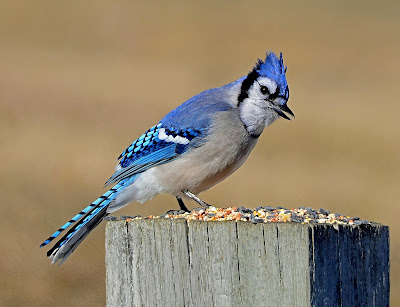Sea Ice Insulates the Ocean Beneath It
We have had a cold past week -- temperatures hovering down around 0 degrees Fahrenheit. It’s amazing to me that birds and other animals can tolerate these conditions with such seeming equanimity. Ducks hang out in icy water. And while wild birds prefer open water to drink, they can get what they need from snow or any food that has some water content (like insects and wild fruits) - but I worry anyway and sporadically put out little dishes of water around the bird feeders, which probably aren’t much help since they freeze so quickly. Kids are skating on the local ponds and the stream out back is gurgling under a bubble-strewn cover of ice, icicles dangling down into the rushing water beneath.
Salt water has a lower freezing point than fresh, but with these sub-zero temperatures it too is freezing over. Chunks of ice are accumulating in the harbor, pushed up against the dock and shore by waves and wind - seeing this, I can pretend I am looking down from an icebreaker pushing through sea ice near the north pole.
Sea ice can take on different forms and has different names to suit -- brash ice, grease ice, ice cakes, pancake ice. The sea ice I saw in the harbor was pancake ice, so named because it is roundish (like a pancake) with upturned edges. Pancake ice forms in rough seas. As the seawater begins to freeze, it forms tiny, millimeter-wide crystals called frazil. This thickening slush on top of the water (sometimes called grease ice) starts to solidify into sheets. Waves break the sheets apart and the edges of these smaller sheets (the pancakes) start to roll up as the pancakes collide with each other. These collisions also produce keels on the bottoms of the pancakes.
While sea ice isn’t common down here in the Gulf of Maine, up in the Arctic the seasonal ebb and flow of sea ice plays a fundamental role in the health of polar ecosystems and of our planet. Without it local conditions, even global conditions, will change. For example, as sea ice forms, salt is expelled from the mix -- this increases the salinity of the water causing it to sink down to the ocean floor. This sinking water flows along the ocean floor back to the equator as part of the global currents of water that move heat around our planet. The sinking water also mixes the water column resulting in nutrients rising to the surface. The sea ice dampens wave action near coastlines, protecting them from erosion. The loss of sea ice in the Arctic is causing coastlines to erode at an accelerated rate. Just as ice forms an insulating layer over our local ponds, sea ice insulates the ocean beneath it -- trapping heat (the ocean stores a lot of heat, which it gradually releases over the winter) under the ice. That layer of sea ice results in colder and drier conditions.
While sea ice might help to insulate the ocean beneath, it is also very reflective and has a net cooling effect on global temperatures. Sea ice has high albedo -- meaning it reflects a good amount of incoming solar energy back into space, helping to cool the planet. Because of global warming, the amount of Arctic sea ice has been diminishing, which in turn accelerates global warming. Because there is less ice to reflect incoming solar radiation and more open water to absorb it, the northern seas warm more quickly, more solar radiation is absorbed by the planet, and so the rate of global warming increases.
Sea ice is also vital to polar food webs. We’ve all seen photos of polar bears stranded and starving on tiny clumps of sea ice, unable to hunt for seals. Arctic sea ice, which is fast disappearing, is a critical habitat for a variety of large well-known animals like polar bears, seals, and penguins. But what most of us forget about are the little things -- for example, when sea ice melts in the summer it releases nutrients into the water that feed phytoplankton which in turn feed everything else in the polar seas.
The sea ice showing up in our local harbors is just a taste of that expanse of ice that is rapidly diminishing up north. Since satellites first started recording Arctic sea ice, it has lost more than half its volume -- it is getting thinner and covering less area every year.




Comments
Post a Comment